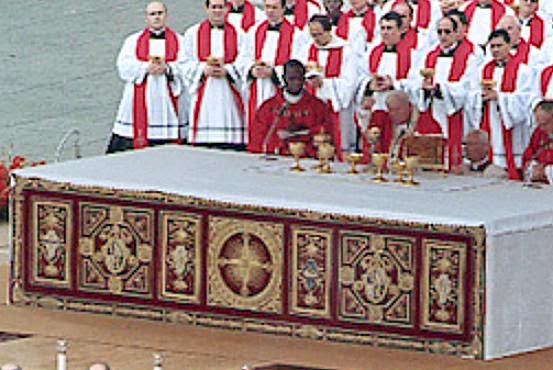Cardinal Burke: No change in divorce, annulments
Not only should Catholics who have divorced and remarried not expect permission to receive Communion following the upcoming synod of bishops, but any streamlining to make the annulment process easier is unlikely, too.
That was the message from Cardinal Raymond Burke earlier today, in which he blasted those who advocate for change to the church’s prohibition on divorce and the loosening of the annulment process. He said any changes would “only further encourage a defective view of marriage and the family.”
Speaking with reporters on a conference call hosted by Ignatius Press, Burke said that restructuring the annulment process — which some say is church discipline open to adjustment and not core doctrine — would lead Catholics to believe that the church isn’t serious about its prohibition on the “insolubility” of marriage.
Burke, who heads up the Vatican’s Supreme Court, upped his public feud with another cardinal, Walter Kasper, dismissing Kasper’s proposal that the church restructure its annulment process.
“The Kasper positions have been discussed some decades ago,” Burke said, and “we came to the conclusion that the solution proposed by Cardinal Kasper is fundamentally flawed.”
Kasper said earlier this month that Pope Francis shared his beliefs.
“They claim to know on their own what truth is, but Catholic doctrine is not a closed system, but a living tradition that develops,” Kasper told the Italian daily Il Mattino. “None of my brother cardinals has ever spoken with me. I, on the other hand, have spoken twice with the Holy Father. I arranged everything with him. He was in agreement. What can a cardinal do but stand with the pope? I am not the target, the target is another.”
Burke, who was removed from the Vatican’s Congregation for Bishops last year by Pope Francis, bristled at this characterization.
Burke said proposals like Kasper’s are “disobedience to, or a non-adherence to, the words of the Lord himself.”
According to church teaching, Catholics who remarry civilly without an annulment of their first, sacramental marriage may not receive Communion unless they abstain from sexual relations, living with their new partners “as brother and sister.”
Critics say the annulment process can be expensive, demeaning, and take too long. Some Catholics have expressed hope that the synod may streamline the annulment process, and Kasper has been at the forefront of that movement.
“He is proposing a direction that in [its] whole history, the church has never taken,” Burke said.
James Hitchcock, a professor at St. Louis University, said that a change in the church’s prohibition on Communion for the divorce and remarried could alienate those living by the current teaching.
“There are people who have lived heroically by the teaching of the Church. They have not received Communion in living in the teaching of the Church, and they cannot be brushed away,” he said.
Burke defended his public challenge to Kasper and other bishops.
“For everyone to simply be silent while they see things being said that are not true, how can this be construed as being charitable?” he asked.
Rev. Joseph Fessio, a Jesuit priest and head of Ignatius Press who also was on the call, agreed. He called the focus on divorced and remarried Catholics a “very important, but very small issue” that Kasper’s ideas have amplified.
Still, he said that the public dispute was a blessing for the church.
“I don’t think it’s a bad thing these disputes are known; in fact, I think it’s a good thing,” he said.
“Remaining in the Truth of Christ,” which Ignatius Press will publish Oct. 1, includes essays in response to Cardinal Kasper’s proposal by three synod fathers: Cardinal Gerhard Muller, prefect of the Congregation for the Doctrine of the Faith; Cardinal Burke, prefect of the Supreme Court of the Apostolic Signature, and Cardinal Carlo Caffarra of Bologna, Italy.
On the same day, Ignatius Press will also publish two other books in which synod fathers respond to Cardinal Kasper’s proposal: “The Hope of the Family,” an extended interview with Cardinal Muller; and “The Gospel of the Family,” which features a foreword by Cardinal George Pell, prefect of the Secretariat for the Economy. (Cardinal Kasper’s address, published by Paulist Press, is also titled “The Gospel of the Family.”)
Burke believes he said continuing the ban on divorce will strengthen marriage, and that the stakes are high.
“If the family is not strong, and the institution of marriage is not strong, society is in danger,” he said.
Material from Catholic News Service was used in this report.

































